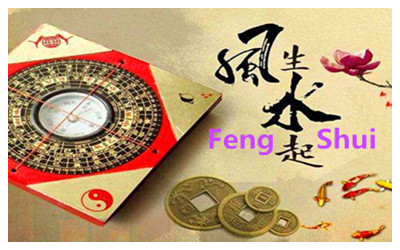
Chinese Feng Shui
Feng Shui is an ancient Chinese belief system that addresses the layout of cities, villages, dwellings, and buildings. Feng Shui is also regardded as the ancient Chinese art and science of balancing energies within your environment, the home or work place, to create good health and good fortune.
 Feng means wind and shui is water. Ancient Chinese culture associates a gentle wind and smooth, free-flowing water with having plenty and being healthy. Famine and disease are linked to harsh winds and stagnant water. So, good Feng Shui clears the way for a good livelihood and health whilst bad Feng Shui is believed to cause hardship, misfortune and ill health.
Feng means wind and shui is water. Ancient Chinese culture associates a gentle wind and smooth, free-flowing water with having plenty and being healthy. Famine and disease are linked to harsh winds and stagnant water. So, good Feng Shui clears the way for a good livelihood and health whilst bad Feng Shui is believed to cause hardship, misfortune and ill health.In its original expression:
Wind that which cannot be seen — invisible.
Water that which cannot be grasped — elusive.
Fēng Shuǐ = (A life-force/entity that is) Invisible & Elusive.
Traditional Feng Shui involves the use of a Luopan compass and a systematic method involving iterated steps.
What's more About Feng Shui
The words translate from 'Feng' meaning wind and 'Shui' meaning water. However, the real explanation of what it really means is based around the invisible Ch'is energy which is carried along by the wind and water.
The words translate from 'Feng' meaning wind and 'Shui' meaning water. However, the real explanation of what it really means is based around the invisible Ch'is energy which is carried along by the wind and water.
Chi Energy
About 3,000 - 5,000 years ago, Feng Shui was first developed based on the Chinese principle that everything in nature is made up of vital energy - called Chi ( 气 qi ). And that energy can be good - bringing success and well-being - or bad bringing misfortune.
If you want to understand how Feng Shui works, you need to learn about Ch'i energy - invisible energy. This energy flows through the air, similar to the way radio waves or satellite transmissions work.
Ch'i is a source of prosperity, harmony, health and honour. To allow for it's full effect it should be accumulated gently, but it must never be trapped otherwise it will stagnate and turn into "bad ch'i" which brings bad luck. Since Ch'I is energy, places where it gathers become rich, full of opportunities and luckier. Places where this energy is absent, life is barren and unproductive. Much of the practice of Feng Shui is to allow the Ch'i to flow throughout your living space.
Yin and Yang
Yin and Yang symbolise energy also, where Yin is symbolised by a broken line represented as a female passive energy whilst Yang is symbolised by an unbroken line, the opposite of Yin and is represented as a male active energy. This will be explained in detail at a later stage.
The Pa Kua (bagua)
One important Feng Shui formula concerns the eight main life Aspirations, corresponding to the four cardinal Directions and the four inter-cardinal Directions of the compass (Lo Pan).
Each of these Aspirations is symbolized in the octagonal shaped Pa Kua, one of the most basic Feng Shui tools, which identifies where the particular Aspirational locations lie in your home or workplace, allowing you to energize them as required.
This will stimulate positive chi (life force) flow and create good Feng Shui for you.
A Bagua Map is a tool used in Feng Shui to map a room or location and see how the different sections correspond to different aspects in one's life. The Bagua Map is based on the I Ching, the Chinese Book of Changes. 'Bagua' is translated directly as 'eight trigram', which describes the eight basic blocks surrounding the center of a room or location. The map is intended to be used to map one's home or office and find areas lacking good chi, and to demonstrate how those physical areas are reflected in one's life







 Ask Questions ?
Ask Questions ?